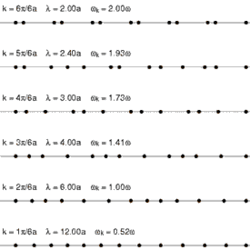PHZ3400 Sound
Harmonic approximation: inter-atomic forces as springs
- If we put energy into a crystal the atoms will begin to vibrate.
- We are able to put energy into the crystal in two ways: Mechanical and Thermal.
- Mechanical energy are sound waves
- Thermal energy can be used to measure resistivity.
- Periodicity helps to simplify the problem of lattice vibrations.
- One atom moves with the frequency
- If we have many atoms moving together than they effectively have a larger mass, therefore they will have a smaller frequency.
- Broken Symmetry
- Collective Phenomenon - behavior changes when in a large group
Example
Consider an molecule. Assume one is at rest while the other moves.
,where is potential energy and is radius. This can be rewritten as
This equation cannot be solved via conventional methods, so we must somehow simplify it. Let us only worry about very small oscillations. This reduces our problem to a harmonic oscillator. Small oscillations can be described simply since it is parabolic at the minimum energy.
Now we expand in Taylor Series (note is the radius with minimum V)
,where .Notice that the second term is the derivative of at , which is a minimum, therefore the derivative is zero and this term can be ignored. Now we have
Now let and we have
and
...
Two Atom Model
- Corresponds to putting in a potential well
- We can reduce this problem to particles on springs
- There is a spring with constant K holding the two atoms together. Also, we put them in a potential well such that we can imagine a spring connected each part individually to a wall, with spring constant Q
- Solve via eigenvalue analysis
- Two Modes
- Both Particles move in concert
- Both Particles move opposite to each other
- If one of these particles are displaced (ignore the effects of the second) it will act as a linear Harmonic Oscillator, so that it will act as a simple sine wave.
- However, if you take into account the second particle, the problem will not be so simple since there will be a superposition of two since waves creating a beat pattern. If the displacement is described by one of the modes above then there will be a simple sine wave.
We can write the equations of motion for these two particles as
,where and are the spring constants, is mass, and is displacement from the particles equilibrium position. This can be re-written as:
We can create a matrix representation for this system of equations by letting
and choosing the interaction matrix, to be
Now we can rewrite our system of equations as
One dimensional mono-atomic chain
For this example, we imagine a chain of identical atoms, with mass connected by springs, with spring constant . Since this is only in one dimension we assume the particles only move in a direction parallel to the chain.
There are two forces that contribute to the displacement of the atom,
1)The force from the spring on the left
2)The force from the spring on the right
Combining these we can write the total force as
...

































![{\displaystyle m{\ddot {u}}_{n}=-K[2u_{n}-u_{n-1}-u_{n+1}]\!}](https://wikimedia.org/api/rest_v1/media/math/render/svg/d32966614b0b60007c6cdd133bce1fd28428badb)
![{\displaystyle -m\omega ^{2}=-K[2u_{n}-u_{n-1}-u_{n+1}]\!}](https://wikimedia.org/api/rest_v1/media/math/render/svg/01e6400d21240a9fe7264516862491a9f37a0669)
![{\displaystyle -m\omega ^{2}=-K[2-e^{iKa}-e^{-iKa}]\!}](https://wikimedia.org/api/rest_v1/media/math/render/svg/a5cbba0f0106dadf614941a27cbfd17e53535beb)
